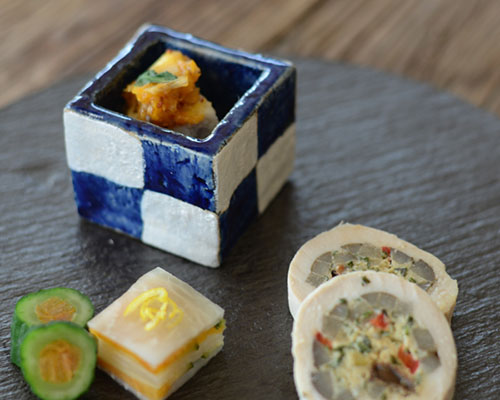当日発送について
平日(営業日)の12時までにご注文が完了したご注文で、以下の条件に該当するご注文を当日配送いたします。
◯ご注文いただいた商品の在庫がすべてある場合。
◯お支払方法がクレジットカード決済か代引きの場合。
◯定休日はではない。
※受注状況や確認事項の有無などにより、お時間をいただく場合がございます。
定休日のご案内
土日祝日、お盆、年末年始などは出荷業務をお休みいたします。
Now Loading...
平日(営業日)の12時までにご注文が完了したご注文で、以下の条件に該当するご注文を当日配送いたします。
◯ご注文いただいた商品の在庫がすべてある場合。
◯お支払方法がクレジットカード決済か代引きの場合。
◯定休日はではない。
※受注状況や確認事項の有無などにより、お時間をいただく場合がございます。
土日祝日、お盆、年末年始などは出荷業務をお休みいたします。
新しい年度が近づき、気持ちも新たになる今の季節。
この時期になると何か新しいことにチャレンジしたくなりませんか?
普段は食卓に取り入れないような器も、今ならどんどんチャレンジできる気がします。
そこで私がぜひ挑戦したいなと思ったのはこちらの器。

「銀彩市松 角小付」
そうです、名前の通り銀彩を使った市松模様の小付です。
市松模様には柄が途切れることなく続いていくことから「繁栄」の意味があり、
子孫繁栄や事業拡大などなど、、、縁起の良い模様なんです。
来年開催される東京オリンピックのエンブレムにも使われていたりと、
日本人なら馴染み深い模様ですよね!

縁起の良い模様に、さらに銀彩まであしらわれているなんて、
なんだかすごくご利益がありそう。
普段使いにはちょっと、、、と敬遠してしまいそうですが、ご安心ください。
豊富なカラーバリエーションでいろんな食卓のシーンにすっと馴染んでくれるはずです。

白・黒・ルリ・織部と4種類の色があり、
白をさりげなく取り入れたり、黒でシックな印象にしてみたり、
ルリや織部でワンポイントのような使い方をするのも良いですね。
食材の色によって使い分けをしても楽しそう。

こんな風にいろんな色を並べて使っても可愛いですね。
ちなみに、この銀彩市松には荒土が使われています。


1つ1つの表情が豊かで、素朴な雰囲気もあるので、
普段の食卓に取り入れやすい、温かみを持つ器でもあるんです。
また、サイズ感も主張しすぎない大きさなので、はっきりとした模様でも
さりげなく食卓に馴染んでくれます。

もちろん縁起の良い市松模様は、特別な席でも活躍してくれるので
1つ持っておくと重宝しますよ。
市松模様と銀彩が目を引く「銀彩市松 角小付」。
ぜひこの機会に、今まで使ったことのないような器にチャレンジして
毎日のお食事を楽しみませんか?
「銀彩市松 角小付」が気になった方はこちら>>